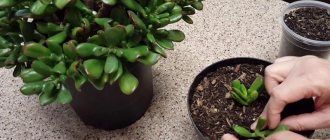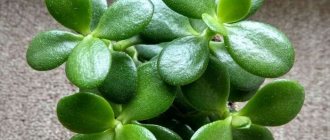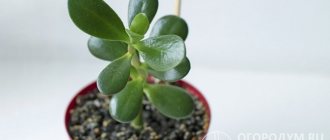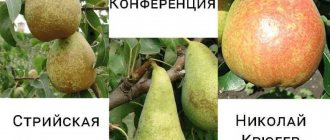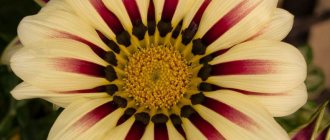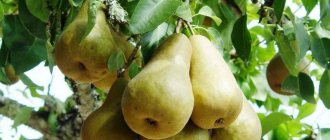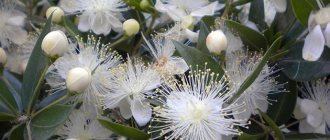Who is Crassula
Crassula (crassula) was born in South Africa, and received its name due to its thick and fleshy foliage. It has many varieties and is propagated in two ways: seeds and cuttings.
Crassula's homeland is South Africa.
It is believed that this plant is able to purify the air in the room where it grows, as well as bring prosperity and material wealth to the house. Crassula is called the money tree and is classified as a talisman plant.
When keeping Crassula at home, you should beware of direct rays on the foliage and stagnant air. Crassula feels best on a south-east window in a regularly ventilated room. The plant tolerates the winter period well in southern windows, and in the warm season it prefers to be in the fresh air.
The fat woman feels good on a lighted window without direct sunlight
Water the fat plant a couple of times a week if the days are hot, and at a temperature of 18–23°C, one watering is enough. In autumn and winter, it is better not to keep Crassula near heating devices, despite its tolerance to dry air.
The fat woman may not survive direct sun or the scorching heat of a radiator
Feed the fat woman no more than twice a month in the summer and once a month in the winter. The ideal fertilizer for this plant would be one that is suitable for cacti and succulents (only in a dosage reduced by half). Any fertilizing is applied to moist soil.
You can’t replant the fat plant too often. This should be done as a last resort, when the root system of the plant has already filled the pot. This usually happens once every three years. A mixture for cacti is suitable as soil for the Crassula. You need to take a shallow pot and put a drainage layer on the bottom.
The superficial root system of Crassula allows it to be grown in shallow containers
Video: caring for a fat woman
What diseases do Crassula have, their treatment and photos
Most Crassula lesions are associated with fungal or bacterial-viral infections . Favorable factors for their appearance include cold and dampness in the room, excessive watering in winter. The following describes possible diseases of the fat woman and presents their photos.
What to do if the plant suffers from bacterial pathology?
Common diseases of succulents include:
Mosaic epiphyllum
Slightly in-depth, transparent, blurry yellow spots appear on the plant tissues. There is no treatment for the pathology; the flower must be destroyed .
Leaf yellowness
Causes a gradual change in leaf color to a yellowish color. The disease affects young shoots; during flowering, the buds dry out and fall off.
To preserve the succulent, it is necessary to excise all affected areas.
Tissue proliferation
Resembles cancerous tumors and is associated with attacks by pathogenic bacteria. Crassula can resist the disease for several years , continuing to grow and bloom, but after a while it will still die.
Important! Bacterial-viral diseases cannot be cured. The only way out is to remove the diseased plant from its healthy counterparts.
How to deal with a fungal disease of a flower?
Symptoms of diseases caused by fungal infection and further treatment depend on the type of pathogen.
Fusarium
It grabs the roots and gradually spreads to the green part along the conductive veins of the succulent. When cutting a leaf, the rusty tint of diseased tissue is clearly visible . Externally, the plant stops growing, the foliage and trunk become lethargic and turn pale.
Diseased areas are cut out with a sharp scalpel or knife, followed by treatment with a fungicide. Subsequently, the flower is kept in a dry room until the wound is completely healed. Crassula is transplanted after pre-treating the soil and pot with Fitolavin, Trichophyte or Fitomporin-M.
How to treat late blight?
Causes rotting of the root collar of the money tree and the subsequent spread of infection throughout all parts of the plant. It is manifested by the appearance of gray-brown spots on the green parts, rotten areas die off.
Damaged areas are cut off, the cut areas are sprinkled with charcoal powder or treated with a disinfectant solution. Measures will give results only in the first stages of the development of this disease ; in other cases, the succulent is disposed of.
Brown spot (anthocrosis)
Anthocrosis appears as round light spots deepened inside the leaf blade, or as a brownish spotted lesion that causes drying, hardness and crusting on the foliage.
Treatment is successful only at the beginning of the development of the disease; it involves excision of problem areas and sprinkling them with charcoal. The appearance of the flower is not restored.
Wet rot
It grabs the stem and spreads quickly - the plant can die in a few days . If the lesion is minor, the diseased tissue is removed, and the cut sites are treated with an antiseptic solution.
If discovered late, the succulent cannot be saved. The cause of wet rot is considered to be watering with cold water and waterlogging of the soil.
Dry rot
Dry areas appear on the stems, under which there are dried tissues. The disease cannot be treated; the money tree is destroyed. To prevent the spread of dry rot to the remaining flowers, the pot and window sill are disinfected and treated with fungicides one-time.
Important! Most fungal diseases can be successfully treated only at the beginning of their development. In other cases, getting rid of Crassula is the only way not to lose all the other house plants.
Insect pests
Plant parasites are something that any indoor plant grower faces, including the owner of a money tree. Dealing with pests is much easier than dealing with bacteria or fungi.
Shchitovka
The scale insect is quite easy to detect: light brown tubercles or spots with a yellow tint can be seen on the surface of the leaf and stem.
It's not difficult to fight her. Insects are collected by hand, and then the plant is treated with a soap solution or Fitoverm. This bio-product must be used according to the instructions; it is safe for humans and plants, but extremely effective against plant pests.
The scale insect on the Crassula leaves clear signs of its presence
Spider mite
Spider mites are very small insects that cause enormous damage to the plant. Despite its small size, the tick can be seen with the naked eye. It looks like a small gray or red dot that is in constant motion. A clear manifestation of a mite attack is a cobweb enveloping the leaves of the fat plant, as well as yellowing or browning of the leaves.
Spider mites leave visible marks on the occupied plant
If you find a tick on the Crassula, you should immediately spray the plant and immediately put a bag on the Crassula, tightening it on the pot. In conditions of high humidity, the tick will die. Other means to combat the pest are a soap solution or the Apollo preparation.
Mealybug
This is a fairly frequent visitor to the Crassula. It likes to be located on the roots and in the axils of leaves, feeding on plant tissues and gradually weakening the bush’s immunity. In addition, it spoils the appearance of Crassula, covering the greens with powdery secretions that resemble cotton wool.
The mealybug on the Crassula is visible to the naked eye
The scale insect is easily washed off the foliage with a stream of water. After getting rid of insects, Crassula is treated with a cotton swab dipped in an alcohol solution or garlic infusion. The drugs Fufanon and Actellik also cope well with the pest.
Root mealybug
The root bug settles on the roots of the fat plant. It's not easy to find him there. This usually happens during the spring transfer of the plant to another pot.
If a scale insect attacks, you should wash the roots of the plant under running water (temperature 50°C), and then treat the root bundle in a solution of Fufanon or Actellik (twice with an interval of 7–8 days).
The root bug unfolds its activity inside the root system
How many years does a money tree live, what can harm it?
If you properly care for the tree, it can live for about 50 years. But this is very rare. The standard lifespan of crassula is 20-30 years.
Improper care, lack of fertilizers, money tree diseases and pests - all this affects the development and lifespan of the plant.
Healthy money tree
What to do to revive Crassula
The most common problem in keeping Crassula is trunk rot. Having received a beautiful mini-tree with fleshy foliage, the beginner, apparently, succumbs to the false impression that such greenery must be fed intensively, and begins to mercilessly flood the Crassula.
Meanwhile, if the soil in which the crassula grows is not allowed to dry out, excess moisture at the root collar will cause tissue rotting and the stem will separate from the roots. In this case, it is impossible to revive the plant.
Flooding of the plant leads to the death of the Crassula trunk
The plant can only be saved by rooting cuttings. To do this, you need to perform a certain algorithm of actions.
- The plant must be carefully examined and healthy cuttings of at least 10–12 cm must be selected.
Crassula cuttings must be healthy and strong
The selected cuttings are carefully separated from the mother plant and left to lie at room temperature for a day to wither. The branches are rooted in water. First, their trunk is exposed, cleared of leaves. Cuttings standing in water should not be in bright sun; they will be more comfortable in partial shade. By the third week, the plants will be ready to move into a separate pot.
Crassula cuttings will quickly take root in water
To transplant a rooted branch into a pot, you should prepare the container: wash the pots in hot water and soap, and then disinfect them in a strong solution of potassium permanganate. The container should not be large, as it is a transfer point for the cuttings.
The container for the cutting should be proportionate to the shoot
A 7-8 cm drainage layer of expanded clay is laid on the bottom of the pot, and half the container is filled on top with a mixture of equal parts of river sand and turf soil. Using a pencil, make a 2-3 cm hole in the pot with soil, where the cutting is carefully placed. Not reaching the edge of the pot 2 cm, add the remaining soil mixture. The cuttings are watered with settled water at room temperature. Each subsequent moistening is carried out only after the earthen clod has dried.
If watered incorrectly, the cutting may rot.
A young plant cannot be moved to another place until it is completely rooted in the soil and finally transplanted.
Quarantine for new plants
Crassulas purchased from amateurs or in retail chains must first be placed separately from the main collection for 2 weeks in the following place:
- cool;
- shaded (but not dark);
- well ventilated.
Owners should monitor new plants for early signs of disease or pest infestation. Before selling, they are often washed off to get rid of external signs, but the problem remains.
Before sending it to a permanent place, the fat woman needs to be cured.
Red leaves of Crassula
Reddening of the foliage of a decorative indoor flower may indicate the negative impact of too much sunlight. Despite their tropical origin, almost all types of Crassula cultivated in indoor floriculture do not tolerate prolonged exposure to the sun.
Reddish coloring of the foliage may appear as a result of moving the flower pot with the plant to a more illuminated place. In this case, it is recommended to spill the soil of the flower pot with a solution based on Epin, diluted at the rate of a couple of drops per glass of water. If redness is observed on the underside of the foliage, then it is necessary to adjust the irrigation regime in order to prevent the earthen ball in the flower pot from drying out.
How to distinguish which disease?
It is quite difficult to figure out what exactly caused the leaves to turn black. Insect pests can be identified on roots or leaves, but diagnosis of the disease is a matter for professional florists.
The main signs of diseases and other problems on the leaves:
- single black spots in the middle of the leaf blade - sunburn;
- red spots resembling rust - a bacterial infection;
- brown spots are a manifestation of fungus (Botrytis cinema and Fusarium oxysporum);
- wet brown spots - rotting roots due to excess water;
- drying with dry dark spots - lack of moisture;
- black rotting roots - too much watering or bacterial infection;
- rotten black trunk or black stems - excessive watering or rot from a fungal disease;
- brown rather than black spots with a sticky substance are most likely a scale insect pest.
The appearance of the plant will always tell about the disease. If there are black spots in the middle of a pair of leaves, then perhaps the tree has simply received burns. If many leaves turn black and the fat plant begins to wither entirely, “it’s time to sound the alarm” - there are signs of a serious disease.
Useful tips
In order for the money tree to live the years allotted to it and all this time to please the eye with its fluffy crown, you should remember some points:
- Constantly check the soil moisture. Do not water the plant if the soil is less than half dry.
- Before planting the fat plant for the first time, heat-treat the soil; this will destroy harmful fungi, microorganisms and parasite larvae.
- Whenever you prune, treat the cut with activated carbon for medicinal purposes.
- Regularly ventilate the room where the fat plant is located to reduce air humidity.
- Periodically inspect the plant for damage. This will help to timely notice pests and diagnose the disease.
- To prevent root rot, add a piece of charcoal when replanting into the soil.
The soil
The most suitable soil for Crassula is a special ready-made substrate for succulents. It is very loose and light, designed for delicate roots. Such soil easily allows water and air to pass through. But you can prepare the soil yourself. To do this, you will need equal parts of leaf soil, turf soil and coarse sand. To quickly remove excess moisture, the pot must have a drainage layer of at least 4 cm.
The substrate for Crassula should be airy and light
Signs associated with falling leaves
It is generally accepted that the falling leaves of the money tree certainly mean impending losses - material, moral, and in terms of health.
There is another opinion. If you look closely at the dry fallen leaves of the money tree, they will look like slightly dusty gems. This similarity is recommended to be used as a very powerful talisman to attract money. Dry leaves are collected and placed in a special bag, which is kept in the wallet.
Before you accept any sign for yourself as the most likely, you still need to remember that this phenomenon - leaf fall - is just a way for the money tree to reproduce in natural conditions and grow - in the place of the fallen leaf, a bud soon appears, from which it develops new escape.
Bacterial diseases
The cause of blackening of foliage is often bacterial rot. The inside of the Crassula trunk becomes black, and externally the disease manifests itself in the form of spots on the leaves.
The “trouble” is treated with fungicides and antibiotics (penicillin, gentamicin and others). Fundazol and Topaz help well against bacterial rot.
As in the case of a fungus:
- Clean and wash the plant with water or soapy water.
- Remove all black leaves and roots.
- Spray the tree with a solution diluted with water (usually the proportions are indicated on the package).
- After some time, replant the tree in another soil.
Wash all working tools thoroughly before using them on healthy plants. Bacterial infections can be very contagious.
After replanting, treat the plant several times with medicinal solutions (after about a week) until the problem disappears.
Advanced lesions due to bacterial infection cannot be treated. The plant will definitely die.
But most often the cause of blackening is a fungal infection, not bacteria. Infection with bacteria is more evident in brown spots, sometimes with a yellowish coating.
Reproduction
Crassula propagates extremely easily by seeds, shoots and leaves. The last two methods are the most popular.
Seeds purchased in a store can be planted in a succulent substrate mixed in equal parts with river sand. They do not need to be buried or sprinkled. Simply shake the container so that the seeds are mixed with the soil, moisten by spraying, cover with film or non-woven material and place in a warm place. After 1.5–2 weeks, shoots will appear. Grown plants must be picked into separate cups.
With leaves and shoots everything is much simpler. Crassula often sheds its leaves on its own. After some time, you can notice that the leaf has successfully taken root. Subsequently, a new plant will emerge from it. The shoot must be planted in a ready-made moistened substrate without waiting for roots to form. Watering should be careful, without waterlogging the soil.
Photo gallery: methods of propagation of Crassula
Propagation by leaves is a method that Crassula itself uses, because the leaves easily take root in the soil. The most popular and fastest way to propagate Crassula is through cuttings of an adult tree. After the appearance of the second true leaves, Crassula shoots must be planted in separate cups. Shoots of young Crassula shoots appear 2 weeks after sowing
Chemical composition and pharmacological properties
Although serious scientific studies of the chemical composition and pharmacological properties of the Crasula have not yet been carried out, traces of arsenic compounds have been found in it. This circumstance is the main limitation for the use of crassula by official medicine.
However, ancient doctors quite widely used arsenic for a wide variety of diseases. Flavonoids found in Crassulaceae help strengthen the vascular wall. Treatments for Crassula practiced in folk medicine are associated with its anti-inflammatory, regenerative, antimicrobial, antiviral, and antipruritic properties.
